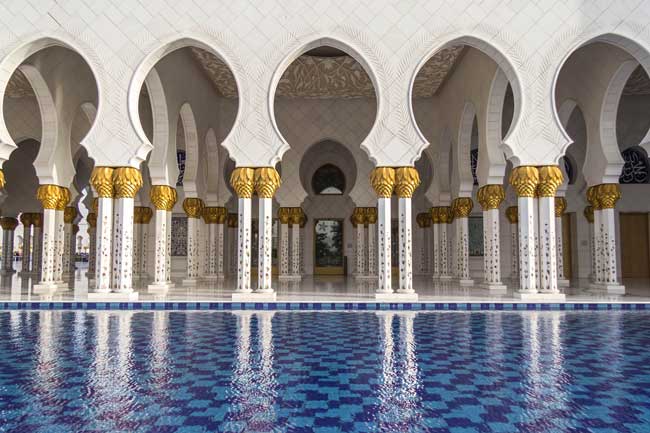
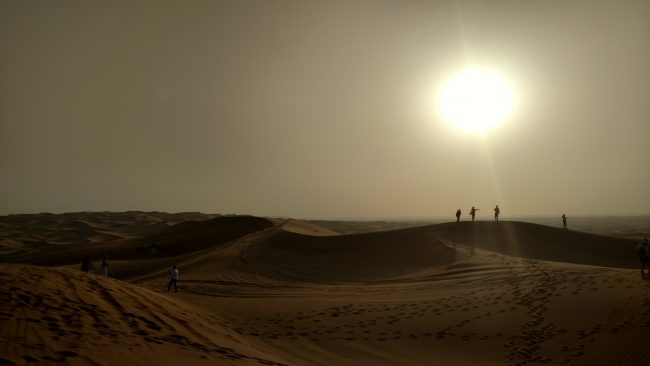
Dubai and Abu Dhabi are cities of contrasts — each one an oasis of modern architectural marvel in the center of desolate desert dunes.
Both cities are in the United Arab Emirates, but each offer a different travel experience.
Travel in Dubai
When flying into Dubai, or viewing the surroundings from the observation decks of the Burj Khalifa or Burj Al Arab.
It’s easy to see that you’re in the middle of a desert: sand as far as the eye can see in three directions, the blue of the Persian Gulf (or Arabian Gulf as they call it) in another direction.
But from the bottom looking up, as we walked the streets and marveled at majestic skyscrapers, smelling flower gardens and admiring the greenest of grass in parks and medians.
It was easy to forget we were in the middle of a desert. It felt like any other modern city — only bigger and, in some ways, better.
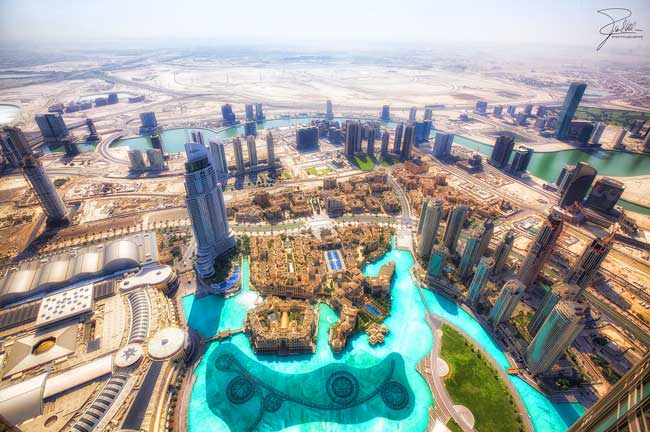
That’s the result of the Emirati striving to go big and best. When you consider how short a time the two cities have been under development, they just may have broken a record on breaking records.
World’s tallest building, world’s fastest elevator, world’s highest indoor ski slope, world’s largest mall, world’s most leaning tower, highest restaurant, highest dwelling, highest observation deck, biggest diamond in a ring and longest automated metro lin.
The list goes on and on of records broken by Dubai and Abu Dhabi.
But they’ve managed to preserve, or in some cases recreate, a bit of the Emirati heritage and architecture.
This is especially notable along Dubai Creek, in the Al Fahidi area of Dubai, and in both city’s Heritage Centers and museums.
Perhaps these record-breaking developments, amidst the remains of the old ways, was all part of the plan to make Dubai and Abu Dhabi premiere tourist destinations.
Their tourist industries are relatively new — and thriving. The nation as a whole, in fact, is relatively new — and thriving — too.
Our first impression of United Arab Emirates was how diverse the population appeared to be, based on who stood with us in the long line to get through passport control.
The ring tones of yesteryear — clamshell cell phones and Nokia texters from the pre-smartphone era seemed to dominate the mass of people — despite the “no cell phone” signs.
The people on these phones appeared to be from India, Pakistan, Bangladesh, Afghanistan, Oman, Yemen, Persia, and other nations from the region.
The most common item of clothing was a thawb, or a long shirt going down beyond the knees with loose pants underneath.
Very few Emirate were present in the crowd — although all of the passport workers were locals.
We tend to be fans of public transportation when we travel, but we figured out that the cost for two of us to take public transportation from the airport to our hotel in Bur Dubai.
It was roughly the same as an airport taxi — and a lot easier. So we hopped in a Mercedes taxi and headed to across the creek to Bur Dubai.
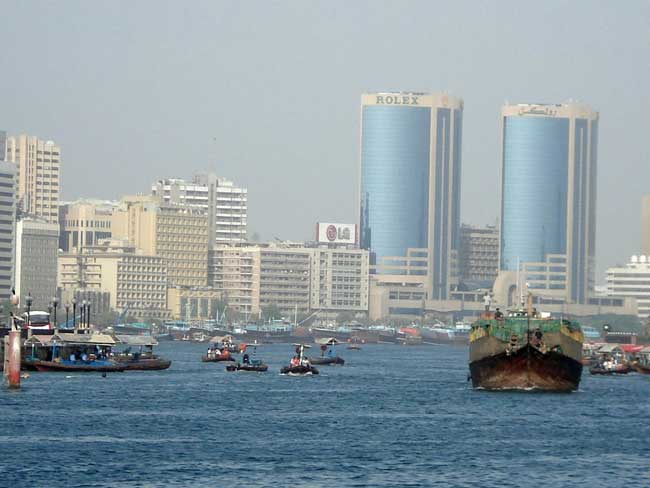
Arabic music swooned on the radio. Traffic signs and advertisements were in Arabic first, English second.
There was a dry heat in the air, even after the sun had set. Mosques lined the corners every few minutes as we drove.
Our next impression, as we drove through Dubai’s twilight, was how modern the impressive skyscrapers were.
Even our modest hotel — The City Seasons Towers Bur Dubai — boasted a fashionable exterior, three glass and mirror towers pressed together with spiral openings at the top.
The mall next door and the metro across the street were practical and beautiful, giving off a futuristic vibe.
We heard the first call to prayer during our stay as we approached our hotel, a mosque within view just, around the corner. There was a mosque on just about every corner, and the chanting reminded us of where we were.
The architecture feels western, but there was no doubt we were in the Middle East.
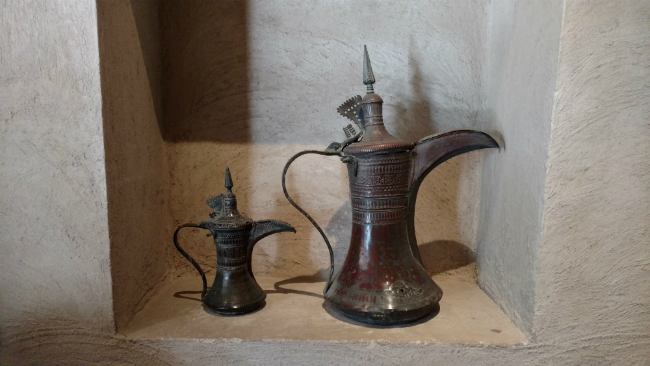
Coffee in the UAE
“The coffee’s great,” Nataliya said as she sipped the Arabic blend. We sat in our hotel’s restaurant, enjoying a breakfast of bean soup, curry, hummus, and fried rice.
“What’s that spice,” I asked. Although this was our first exploration of this part of the world, I fondly remembered mornings with Arabic coffee and tea in college, thanks to a good friend from Saudi Arabia.
There was a certain spice to the sweet, milky, strong Arabic tea and coffee, but I couldn’t recall it.
Our friend, Sadiq, also a friend from college who Nataliya and I both studied with when we were students in Russia, filled us in.
“Cardamom,” he said. “It’s native to India. Very good.”
“Cardamom?” Nataliya repeated. “We usually don’t use that back home.”
Sadiq elaborated. “It’s also very good in rice and curry. But expensive. One of the world’s three most expensive spices.”
“What are the others,” I asked.
Nataliya guessed. “Saffron?”
“Yes,” Sadiq smiled. “Cardamom, Saffron…and fresh vanilla bean. But you can get all three here in Dubai for so much less than in America. I’ll take you to my spice man at the souq later. But first, a tour.”
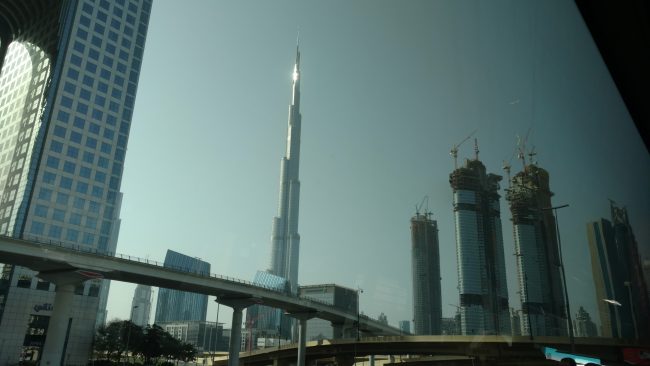
Travel in Dubai: A Museum of Skycrapers
Our old friend, Sadiq, and our new friend, Najeeb, were gracious enough to be our tour guides.
Wanting to show us both sides of the city, we started our driving tour with the places that most tourists want to see first — Dubai Mall and the Mall of the Emirates.
We would return to both on our own for other reasons (namely proximity to other destinations).
But on this tour, we were most interested in the museum of skyscrapers and architectural wonders all around us.
Towering over everything was the Burj Khalifa — the world’s tallest building, holding Shanghai Tower (which we visited in 2014 while it was still under construction) down in second place.
Everything from the stately to the whimsical seems to be represented in the local architecture.
Some of the most interesting skyscrapers can be seen along Sheik Zayed Road, in the financial district. The Dubai International Financial Center looks like a giant cube of stone and glass.
Dubai’s World Trade Center was one of the first skyscrapers built in the city, back in 1979. Some buildings along the strip of skyscrapers have a modern flair, others are more classic in design.
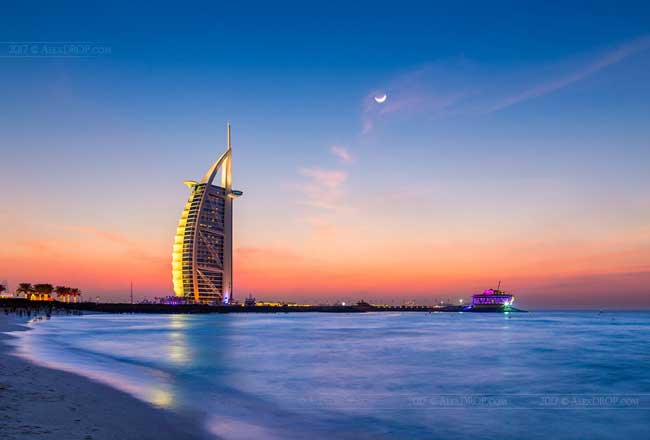
Along with the Burj Khalifa, the other icon of Dubai is the Burj Al Arab, situated on its own man-made island off the Arabian coastline.
From Jumeirah Beach or the Metro or a number of places in the city, the world’s “only seven-star hotel,” as it claims to be, appears to puff out with its sail in the wind along the horizon.
The Hotel Jumeirah, near the Burj Al Arab, looks like an enormous wave of steel and glass along the water.
Dubai Marina is the largest man-made marina in the world, essentially a canal city off the Persian (Arabian) Gulf. Princess Tower, standing above the Dubai Marina skyline, is the world’s tallest residential building.
Infinity Tower, also in the Marina, was the world’s tallest building with a 90-degree twist — and there’s not one structural pillar in the enormous tower — until the twisting Shanghai Tower beat out Infinity Tower when it was completed in 2014.
The audacious feats of architecture in Dubai don’t end with towers. There are the Palm Islands — man-made islands off the coast shaped like giant palm trees in the gulf.
Each palm of the tree is a gated row of multi-million dollar mansions. At the end of one of the Palm islands is The Atlantis.
It is an extravagant resort hotel with its own lagoon and some suites that are under water with aquarium walls open to the lagoon’s diverse habitat of 65,000 marine animals.
“Why visit the aquarium when you can live in it?” I asked.
“It would be very expensive to live here,” Sadiq said.
As we walked the grounds of the Atlantis, a guard bounced us out. “You can’t be here,” he said. “This area is for paying guests.”
“You see?” Najeeb said. “You can’t even look at building and grounds without paying a fee.”
But we did look at the marvelous building, with its enormous Arabic gate in the center. It loomed on the horizon even as we drove off the root of the palm island and back onto the mainland.
Another marvel is “The World,” a project of 300 man-made islands beyond one of the palm islands. The islands are shaped and positioned to form a map of the world.
The man-made islands are either for sale or sold, and they’re intended as resident properties.
The map of the world (like the palm islands) is only visible by air, so going on the islands isn’t as impressive as seeing it from a plane, helicopter, satellite picture…or viewing it from the Burj Khalifa.
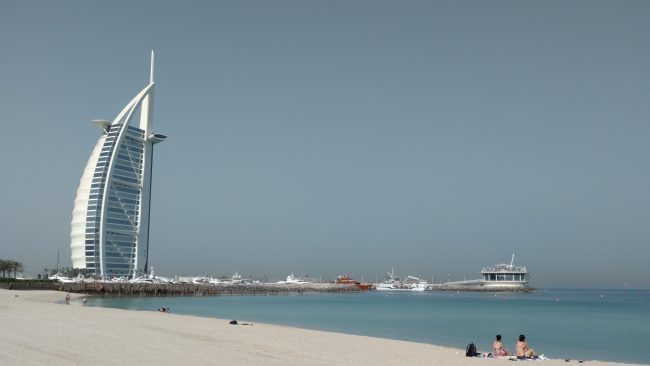
Travel in Dubai: Back to the Old
It’s hard not to see a skyscraper when you’re in Dubai. The Burj Khalifa and Burj Al Arab follow you just about everywhere you go — if you look off to the distance.
But what interested us more than the feats of architecture was a step back into the history to experience the culture of Old Dubai.
The next morning, we left our hotel and went in the opposite direction, to Dubai Creek.
The walk in the cool, 99-degree morning weather was pleasant, and gave us an opportunity to see the nitty-gritty daily life of Dubai up close.
Passing by apartment buildings, offices, storefronts, and mosques, we made it to Dubai Creek in about 45 leisurely minutes.
Dubai Creek is the place to see Dubai of yesteryear. Less than a century ago, this was the heart of Dubai, consisting of sand and palm frond courtyard houses.
In the Al Fahidi neighborhood, an old fort from the late 1700s still stands, and is home to the Dubai Museum.
Throughout the area, old buildings have been restored and new ones recreated in the traditional style, not a far cry from the adobe style houses in the American west.
At Dubai Museum, we immersed ourselves in Emirate history, taking in the traditional barasti, or palm frond house, with its traditional wind tower.
Some of the buildings in the area feature the traditional wind towers, both the sand plaster and the palm ones.
Wind towers provided an early form of air conditioning — catching the cooler wind in the tower and pushing it down into the home below.
The museum displays artifacts from Emirate culture, as well as wax figures of various scenes: a souq, or market, from the 1950s, pearl traders, a classroom, a desert camp, and the likes.
After visiting the museum, we went to the creek and took an abra across to the market area.
The abra is a traditional wooden ferry that carries people from one side of the creek to the other, and it still caters to as many locals as tourists.
Fare was only about thirty cents U.S., and it was a nice five-minute cruise along the creek, offering a pleasant view of the sand-plaster waterfront as we went.
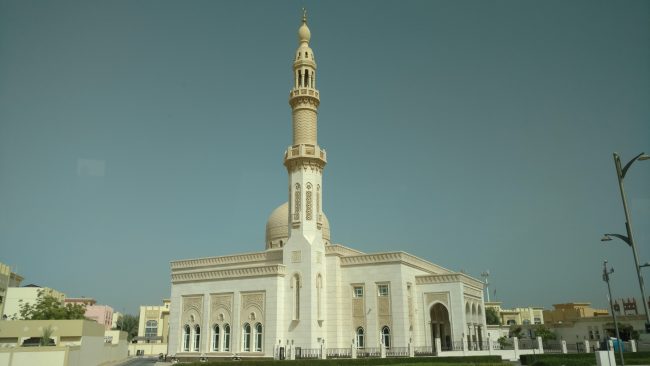
Spicy Souqs and Streets of Gold in Dubai
On the other side of our abra ride along Dubai Creek, we came out right in the heart of the souq area.
Souqs, or markets, have modern conveniences, but we got the impression that they were very much as they were a century ago.
Although you’ll find vendors of all types in each souk, they tend to be focused: one area is the spice souq, another is the textile souq.
And then there’s the gold souq, rich with lavish ornaments and breastplates of gold — even the largest golden ring in the world.
People come from around the world to buy gold in Dubai’s gold souq.
“Just make sure you always haggle with the dealers,” Sadiq advised.
“Got it,” I said with a nod. “Never pay full price.”
“You should start at half price, and find somewhere in the middle.”
We did. Saffron, vanilla, cardamom, menthol, and cinnamon — they were displayed in large sacks along the shops, and we stocked up.
Our task was made easier with Sadiq helping us, especially since this was where he, as a local, came to make his purchases.
He knew the vendors, the true prices, and allowed us to shop as locals instead of tourists.
We were less liberal with our gold purchase, although we did buy a few souvenirs for family back home.
As Nataliya narrowed down the selection to a few pieces, Sadiq and I walked the gold souq’s exterior, discussing old times and new, the history of the world and the state of the world.
“You notice there is no crime here,” he said.
I nodded. “I imagine the penalties are harsh.”
“Not only that,” he said. “There are many plain-clothes policemen, everywhere.
If something were to happen, it would be stopped before there was even time to cause a scene.”
And the truth was, unlike other countries, we’d heard no warnings about watching out for pickpockets.
On the contrary, most warnings involved acting appropriately, not showing public affection or drinking in public.
Warnings intended to protect us from ourselves and the authorities instead of from criminals.
Sadiq and I rendered our opinions on Nataliya’s gold jewelry selections, she made her final choices, and it turned out that democracy prevailed — we agreed on which were the best.
With some gold added to our bags of spice, we left the canopy of the gold souq and strolled into the afternoon sun.
As the call to prayer sounded from a nearby minaret, Sadiq excused himself to go pray. Nataliya and I explored the textile souq, where we ended up trying on what we were told were high-quality local, traditional outfits.
What started as a fun excursion ended in a purchase.
We haggled the price down to below half the original asking price, and ended up adding some handmade wool scarves with intricate embroidery and his and her traditional Emirati garb to our souq purchases of the day.
We greeted Sadiq in our new outfits. He laughed with pleasure. “After a little more sun, you’ll fit right in here,” he said.
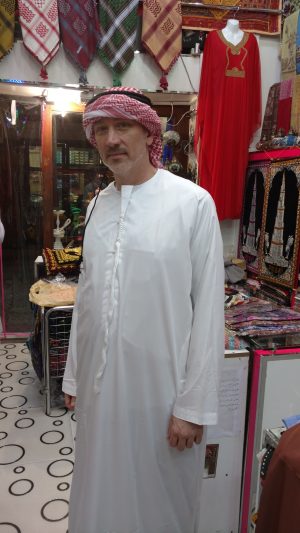
A Bit of Dubai History
We ended our time on the souq side of Dubai Creek with a visit to the Dubai Municipality Museum, right on the creek.
It wasn’t actually in the plan, but the worker at the entrance was so eager that we nearly thought he was trying to sell us something.
“Please, come learn about our history,” he said, gently extending his welcome. “It’s a free museum, all about our culture and history.”
Natalia, Sadiq, and I looked at each other. “Why not?” I said.
He led us inside the sand plaster building and showed us pictures and official papers, explaining in an excited voice the history of the nation and the Emirate
We learned more about the British occupation in the 1800s and late 1900s, the Emirate people gaining independence in the middle of the 1900s, and the establishment of the United Arab Emirates in 1971.
Sheik Zayed bin Sultan Al Nahyan, still pictured on billboards and in buildings throughout the nation, was the ruler of Abu Dhabi and the first president of the United Arab Emirates, running the country for about 33 years, from 1971 to 2004.
We sat at the table where the sheikhs met to form their union. I had the honor of sitting in the sheikh’s chair as we watched a short film on the history of UAE.
Then, we got a look at the official documents forming the nation, the first newspaper, and early writings to come from the country.
Prior to the 1950s, there was little in the area but sand and somewhat temporary houses made of sand brick and palm fronds.
It was the discovery of oil in the 1950s that brought wealth to the nation. But to our surprise, oil is no longer the biggest economy of Dubai and Abu Dhabi. Tourism is.
On the museum’s second floor balcony, we enjoyed a nice view of the creek and the old shoreline on the other side, as well as a new perspective on the wind tower, being directly across from one.
After half an hour’s educational experience, we signed our names and gave our thanks, leaving the municipal heritage center for the abra station.
Where we ferried back to Bur Dubai for a scrumptious meal of lentils, chickpeas, and kabobs with rice and couscous. An avocado smoothie was a filling ending to a full day of culture.
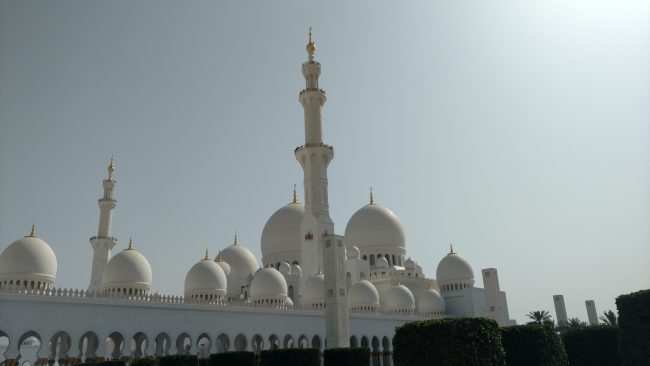
An Excursion to Abu Dhabi
We spent less time in Abu Dhabi, but as it’s only an hour away, and it seems to compete with Dubai for the title of “world’s richest city,” our trip to UAE wouldn’t be complete without an excursion to Abu Dhabi.
Along the way, we witnessed a third city in the making between the two oases: in the middle of the desert, construction was underway on the site of World Expo 2020.
For now, it was just desert and construction, but I imagine it will be something to behold in a few years.
As we approached Abu Dhabi from Dubai, the gleaming white palace of a grand mosque was an amazing sight. The closer we got to it, the more impressive the massive mosque appeared.
It’s the largest mosque in United Arab Emirates, and the eighth largest mosque in the world. Its multiple white domes and four towering minarets gleam bright white. One of those domes is said to be the largest in the world.

The interior of the Sheikh Zayed Grand Mosque was even more impressive than the exterior, with enormous crystal chandeliers, the world’s largest handmade Persian rug, inlaid stone and mother of pearl on walls and pillars, and the world’s largest marble mosaic courtyard.
There was a lot to see in the mosque, but that’s a whole other story.
Besides boasting the largest mosque in United Arab Emirates and one of the largest in the world, as well as the final resting place of the nation’s founder and the mosque’s champion, what else does Abu Dhabi have to offer? Its own collection of records.
The luxurious Emirates Palace Hotel, with its many chandeliers and its lobby liberally smothered in gold, was the world’s most expensive hotel building when constructed in 2005.
Although it was surpassed by the Marina Bay in Singapore. And although it’s a Muslim nation, the hotel featured the world’s most expensively decorated Christmas tree, decked out with more than 180 jewels and watches.
The Etihad Towers are five enormous skyscrapers connected at the base and located across from the Emirates Palace Hotel. A stately rose-gold window tower stands beside it.
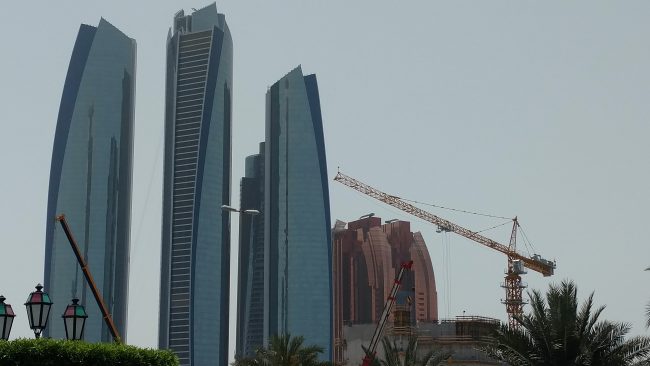
The Capitol Gate building is the world’s most leaning manmade tower, surpassing the lean of the Tower of Pisa.
The Gate Towers boast the world’s highest penthouse bridge, with a floor that people afraid of heights may not want to relax on. Aldar’s Headquarters building is the world’s first circular skyscraper.
The disk appears as a giant pill or coin of glass and metal. The ADIA Tower looks like a sheet of paper swirling back and forth, while another nearby building looks like a rolled up sheet of paper.
Ferrari World, on Abu Dhabi’s Yas Island, is the world’s largest amusement park and it features the world’s fastest roller coaster as well as the largest roof, resembling the hood of a red Ferrari.
The Yas Viceroy is a hotel located over a Formula One racetrack, and it looks like a giant glass fishing net.
The world’s largest book (This is Mohammad) and Atlas are located in Abu Dhabi.
Still under construction are an official Louvre Abu Dhabi and Guggenheim Abu Dhabi, as well as a Sheikh Zayed Musem.
As in Dubai, the one place you can count on seeing locals in Emirate garb is at the mall.
At Abu Dhabi’s Marina Mall, which features an actual full-size mammoth fossil inside and its own version of a London Eye Ferris wheel outside.
It has an express elevator up to a Sky Tower, offering a great view of the coastline, or a meal at the revolving restaurant.
Opting for the less pricy and more authentic food closer to the surface, we just went up for the view.
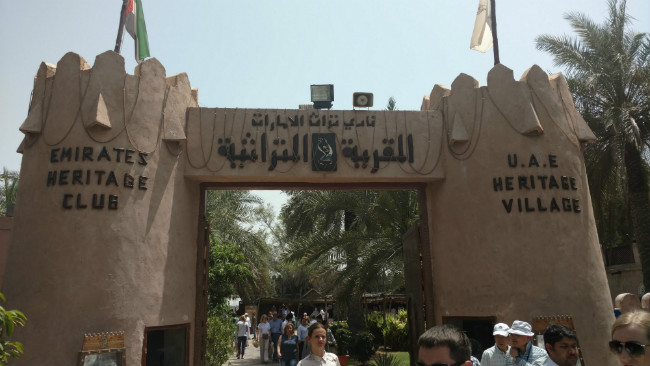
Down a Notch
As in Dubai, it’s the audacious skyscrapers and feats of architecture in Abu Dhabi that amaze, but the history and culture that satisfies—although you have to dig for it.
The United Arab Emirates Heritage Village, run by the Emirate Heritage Club, is a great place to get a feel for traditions and culture before the skyscrapers took over.
Much like a Williamsburg of the United States, this is a working village with craftsmen and craftswomen working much as they would have a couple hundred years ago.
You can watch a glass blower making perfume bottles, a weaver creating scarves or rugs, a tinsmith pounding out Arabic coffee pots, a potter making pottery, and the likes.
The museum displays ancient artifacts from past culture, including early coin and paper money, pottery coffee pots, goatskin containers with the legs still attached.
There are also textiles, camel saddles, weapons, writing desks and utensils, and even a traditional home complete with wind tower, bed, and seating.
It’s worth noting that the center is as much for locals as it is tourists. And that brings up the question: who is local?
Fewer than 20 percent of people who live in Abu Dhabi and Dubai are native Emirate people. Most residents who spend their lives in UAE are foreign workers—who are drawn by high wages and no taxes.
With so much wealth to spend and so many projects in the works, there is no shortage of work for people who want to enter the country.
And UAE is one of the most open-armed when it comes to welcoming workers and visitors alike.
That said, we also learned that there is no path to citizenship for most workers who may end up at the end of a career with no social security or pension and no home.
The children of workers who spend their lives working in UAE are also not citizens, setting them up to either find work in UAE or become strangers in the homelands of their parents.
So, places like these heritage centers, museums, and the extremely popular desert excursions, which include traditional dance and food, are popular for tourists, as well as people who live in the country but aren’t natives.
These programs, excursions, and museums are also popular with Emirati natives, who have an entirely different lifestyle in the wake of wealth, and who want to reconnect with their past.
Its not unlike a modern-day American wanting to visit Historic Jamestown or Williamsburg or a historic inn for a brush with history. There is much to learn from our pasts, after all.
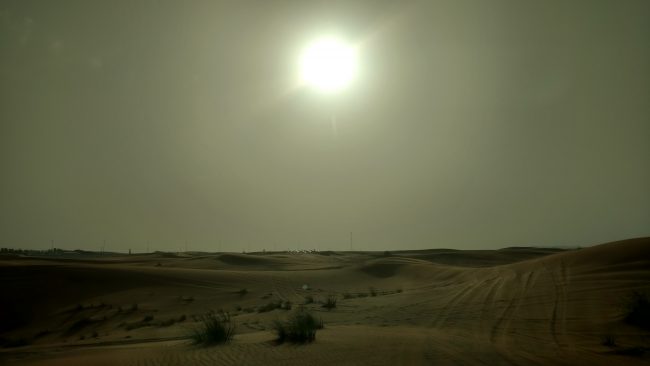
Dubai and Abu Dhabi: Somewhere in the Middle of Nowhere
Dubai and Abu Dhabi are the twin oases of United Arab Emirates. Between the two, Bedouin culture still lives — in the desert.
The middle of nowhere may not seem like the most exciting destination — but it is when you’re here.
The most popular excursion in UAE for a tourist or local alike is to reconnect with the Bedouin culture of yesterday by taking a desert safari.
Our 4×4 Jeep picked us up at our hotel in the early afternoon to begin our excursion. We were comfortably accompanied by our host, Khalid, and two other couples, one from Sochi and the other from Singapore.
We considered ourselves fortunate to have another air-conditioned tour of Dubai’s modern architecture as our Jeep picked up the other couples, and then headed out of the city, into the dusty horizon.
When we hit the desert, the first agenda item was something that has become somewhat of a modern sport: dune bashing.
Khalid stopped the Jeep at the end of the road, the brown-red ripples of the wind-kissed desert stretched out before us.
We got out and enjoyed the windy view as Khalid let air out of the tires, switching from asphalt to sand mode. We got back in, and he got to work.
Squeals of exhilaration and delight erupted inside the jeep as Khalid zoomed up and down the sand dunes.
Sometimes sliding down the side of a dune sideways, often launching the tires off the ground and into the air before plunging back into a dune with a sandy splash.
This “dune bashing” offered the ultimate off-road experience. Before long, we were joined by other Jeeps and Toyota 4x4s along the dunes.
Our collecting band joined another one in the distance.
As though competing, the drivers bashed the dunes, taking turns plunging into an enormous pit and then up again.
“Safety in numbers,” the Singaporean man said. “If one of us has auto trouble, there are others to help.”
That was a good thing, since our thrill-ride over the dunes lasted about an hour.
We stopped in a remote dune sea with nothing but sand as far as the eye could see. Then, we proceeded another ten minutes or so to our camp of Bedouin culture.

Coffee and Dates, Camels and Sunsets in the UAE
At camp, a host greeted us, one by one, with dates and our choice of Arabic coffee or tea.
A man chopped the tops off of coconuts with a machete and offered them for us to drink. After camp orientation, we were allowed to explore.
Nataliya and I opted for a camel excursion first, while the sun was still visible along the horizon.
In the orange glow of the sinking afternoon, we boarded our camel and headed out into the desert for about half an hour’s ride.
Aside from our traditionally dressed guide and the other camels around us, the view was a wonderful sea of sand dunes, dry green bushes, and orange to brown sun as it lowered in the sky.
Occasionally, a falcon looped overhead and then returned to its master back at camp.
After our camel ride, just outside camp, Nataliya and I walked about ten minutes into isolation and enjoyed the desert sunset together.
Then, in the still-light post-sunset dusk, we entered the camp again and partook of the festivities.
We watched a fire dance, with a man juggling fire, swallowing it and dancing with it. As we did, we sat in an open tent and sampled shisha, the Arabic version of hookah.
We opted to pass on the traditional tattoo, or henna, although the woman from Sochi was all over it — or rather, it was all over her.
Seated around the stage, in traditional floor-pillow seats and low tables, we enjoyed a large meal of traditional foods, including dishes of beef, goat, chicken, rice, couscous, beans, chickpeas, and lentils.
As we finished our meals, we enjoyed entertainment on the stage, where the fire dance had been performed earlier.
In a traditional tanoura dance, a man in a iridescent skirt carrying colorful drums spun around in circles so fast and for so long that we were shocked to see him walk in a straight line after.
As he spun, he arranged the drums in different patterns, and his decorative skirt also spun out, creating a rainbow of blurred beauty.
The next beauty to hit the stage was the belly dancer, who shook more than just her belly to the sound of loud applause.
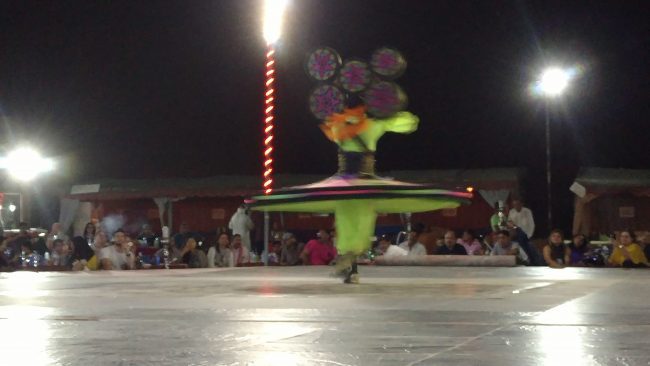
My Dubai
After such a filling meal, we were glad that the dune-pocked drive back to the road was not as wild as the dune-bashing ride to camp.
We returned home using a slightly different route, allowing Khalid to use more road and less sand.
Before long, the city lights were ahead of us, outlining an impressive skyline of record-breaking skyscrapers.
“This is my Dubai,” Khalid said. The cityscape grew larger and brighter the closer we came to it.
“There’s something to be said for the history,” the man from Sochi said. “My city was completely changed because of the Olympics.
Some people can’t even afford to live in their homes anymore, because everything became so developed. It takes a lot of hard currency to make it where a working class man used to live.”
“But it is progress,” Khalid argued agreeably. “It’s nice to say we should still live in the desert like poor people. But we must look to our future.”
“The future is there,” I said, pointing to the bright lights of the big city. “It’s like Vegas on steroids.”
The man from Sochi chuckled. “But we also learned from the Olympics, steroids can get you in trouble.”
Nataliya chimed in. “In a way, it’s like the gentrification of a neighborhood. Some people love it, because it’s good for property values and development.
Some people hate it, because it pushes out natives and draws a new population—the people who can afford it.”
I nodded. “Like, the wealthy are invading and taking over from the poor.”
Khalid shook his head. “It’s different here.” We were now within the city, bright lights towering all around us. “Here, the wealthy are the natives.
Given a choice between camels and palm huts with wind towers, or Maserati and air-conditioned towers of glass and gold, anyone will take the latter.”
“I get it,” I said, sitting in the front seat next to our driver. “The history and culture is the most interesting thing when you’re exploring. But when it comes to daily life, everyone loves comfort and convenience.”
Khalid nodded, looking ahead at the world’s tallest building, and the world’s biggest dancing fountain beside it. “This is my Dubai. My future.”
Watching the spectacle, the enormous water display set to Arabic music, reflected in the mirrored surface of the Burj Khalifa, it was hard to believe less than an hour ago we were in the middle of the desert.
Despite the oasis around us, we were still in the middle of the desert.
Both Dubais — the traditional Bedouin past and the glass and steel future — are Dubai. A city of contrast, to be sure — and unquestionably a city to be reckoned with.
If You Travel to Dubai
Dubai may have gotten rich off of oil, but several people we met in the city boasted that the city makes more money these days from tourism than oil — but that doesn’t mean one of the world’s richest cities has to be an expensive one.
It can be, but if you go off the beaten path, you can find less touristy, more authentic, and more affordable options.
We flew Air Canada (on a United ticket), although from what I’ve heard Emirates Airlines is the best airline to take to Dubai if you can find a deal.
Deals can be found online — we paid less than an average price from Washington DC to Paris or London.
You can find online deals on hotels, too. We stayed at the City Seasons Towers Hotel, which was conveniently located in Bur Dubai.
We managed to find a rate just above 100 a night, for a decent sized, clean, comfortable room — with breakfast included.
The hotel’s location, on Khalifa Bin Zayed Road next to Burjuman Mall, was ideal, situated with Old Dubai and Dubai Creek on one side, and New Dubai and the Sheikh Zayed Road area on the other.
We were a 45-minute walk away from the creek and a 15-minute metro ride away from the Burj Khalifa.
The Burjuman metro was just a three-minute walk away (half of that time waiting for a crosswalk light), and cost only a few dollars. Taxis tended to run around fifteen to twenty dollars.
Dubai’s metro is easy to follow and can get you from one edge of Dubai to the other.
Take the metro to the general area, then a taxi to hone in on your target — that’ll save you taxi fare.
It also gives you the experience of the metro, much of which is above ground, offering incredible, air-conditioned views of the city’s architecture, beaches, sunrises, and sunsets.
If You Travel to Abu Dhabi
For the trip from Abu Dhabi, there are a number of options, including train, public bus, and private coach.
We opted for the latter, allowing us to get to the places we wanted to go with little effort.
Don’t forget your sunscreen, sun hats, sun glasses, and light, breathable clothing. When we went in early spring, temperatures ranged from 99 to 114. In summer months, be prepared for 130!
Finally, keep in mind that this is probably the safest, most westernized, and most modern city in the Middle East.
Have no reservations — other that hotel and restaurant and tours — in deciding to visit United Arab Emirates.
Eric D. Goodman enjoys traveling as much as he loves writing. His fiction and travel stories have been published in many periodicals, including Go Nomad, InTravel Magazine, Go World Travel, Travel Mag, The Washington Post, The Baltimore Review, The Pedestal Magazine, The Potomac, Grub Street, Scribble Magazine, and others. Eric’s the author of the award-winning Tracks: A Novel in Stories about travelers who connect on a train, and Flightless Goose, a storybook for children. His newest book, Womb: a novel in utero was published this spring. Learn more about Eric and his work at www.EricDGoodman.com and connect with him at www.Facebook.com/EricDGoodman.
- Life of a Champion: Exploring the Muhammad Ali Center in Louisville - April 19, 2024
- What It’s Like to Live as an Expat: Lake Chapala, Mexico - April 18, 2024
- Top 5 Spots for Stargazing in North Carolina - April 17, 2024

Abu Dhabi’s nature is a breathtaking tapestry of deserts, mountains, beaches, parks, and wildlife, creating a truly stunning and mesmerizing landscape that will leave you in awe.